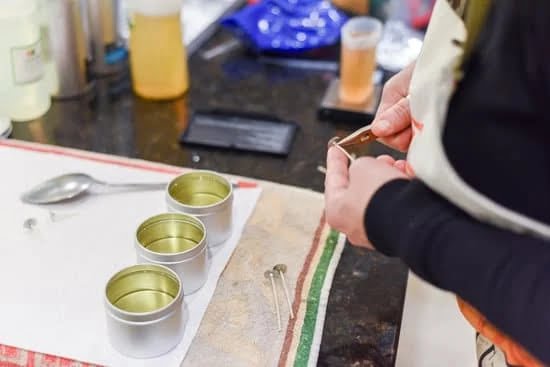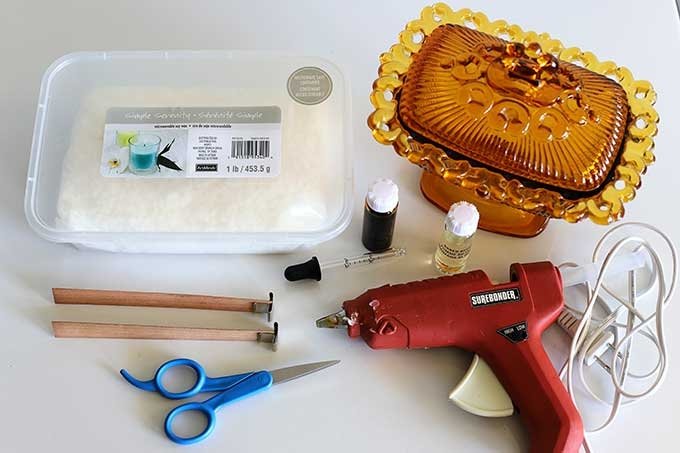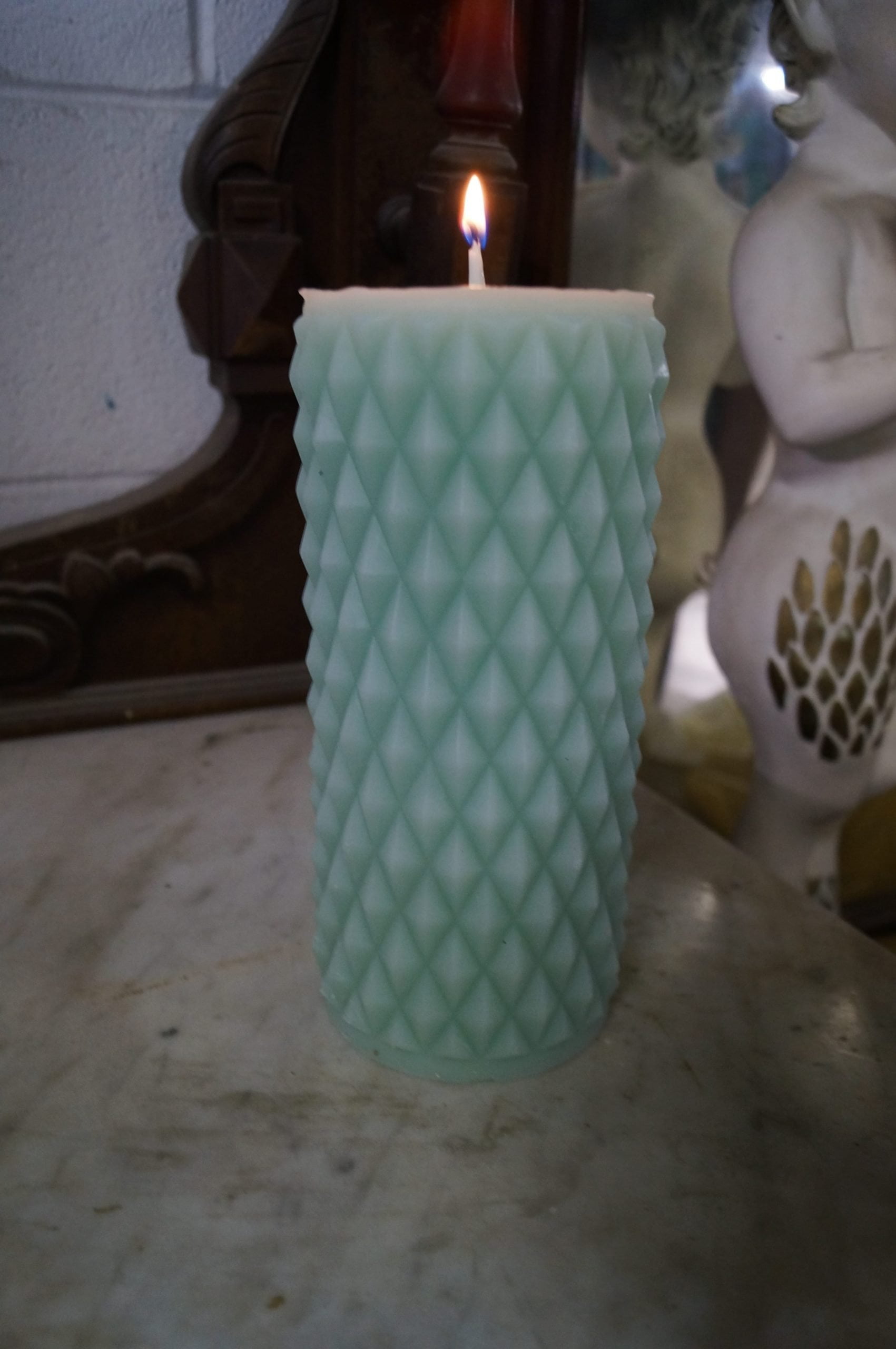The process of making candles has become a popular hobby for many people. From selecting the perfect fragrance to pouring the melted wax into molds, it’s a rewarding and creative experience. However, once the candle-making process is complete, there’s always one burning question in the back of every candle maker’s mind: how soon can you actually burn the candle?
This article aims to answer that very question and provide a comprehensive guide on when it’s safe to light up your freshly made candles. We’ll explore the science behind candle curing and understand the different stages involved in this process. Additionally, we’ll delve into the importance of allowing the initial cooling period and wax hardening before your candle is ready for use.
As exciting as it may be to see your new creation sitting on a shelf, it’s crucial not to rush the cure time. Patience is key here, as prematurely burning a candle can result in poor performance and wasted efforts. Therefore, we’ll also discuss various methods to test your candle’s readiness for lighting, including the finger test and other tried-and-true techniques.
So if you’ve recently dabbled in making your own candles or are considering trying it out, keep reading to find out everything you need to know about when you can safely burn them. Get ready to immerse yourself in the world of candle making and discover the optimal cure time for different types of candles, along with helpful tips and tricks for accelerating this process if you simply can’t wait any longer.
It’s time to light up and enjoy the fruits of your candle-making efforts.
The Science Behind Candle Curing
Candle curing is an essential part of the candle making process that allows the wax to fully develop its scent throw and burn properly. Understanding the science behind candle curing can help candle enthusiasts determine when their candles are ready to be burned.
Candle curing consists of several different stages, each with its own purpose and timeline. The first stage is the initial cooling period, which involves allowing the candle to cool completely after pouring the melted wax into the container or mold. During this stage, patience is key as rushing can cause uneven cooling and potential damage to the candle.
The next stage is wax hardening, where the wax solidifies completely. This process usually takes about 24 to 48 hours, depending on factors such as wax type and ambient temperature. It’s important not to rush this stage as premature burning can lead to poor scent throw and uneven melting.
To determine if a candle is ready for burning, there are various methods that can be used. One popular method is the finger test, where you gently press your finger onto the surface of the candle. If it leaves an indentation but doesn’t feel sticky or soft, then it’s most likely ready for burning. Another method is checking for any discoloration or sweating on the surface of the candle, which indicates that it needs more time to cure.
There are several factors that can affect cure time, including the type of wax used, fragrance load, and dyes. Soy wax tends to have shorter cure times compared to other waxes like paraffin or beeswax. Candles with a higher fragrance load may also require longer cure times as it takes longer for scents to fully develop in the wax.
The Initial Cooling Period
After making a candle, the initial cooling period is one of the most crucial stages in the candle-making process. Patience is key during this time, as it allows the wax to solidify and set properly. Rushing this step can result in an uneven burn and poor scent throw.
Understanding the Cooling Process
During the initial cooling period, the melted wax begins to solidify and harden. This process is influenced by various factors such as temperature, humidity levels, and the type of wax used. Generally, it takes around 24 hours for a container candle to solidify completely. However, pillar candles may take longer due to their larger size and thickness.
Avoid Disturbing the Wax
To ensure a smooth, even burn, it’s important not to disturb or move the candles while they are cooling. Even slight movements or vibrations can cause uneven cooling patterns, resulting in cracks or sinkholes in the finished product. It’s best to find a cool, undisturbed area where you can leave your candles untouched during this crucial stage.
The Benefits of Proper Cooling
Allowing your candles to cool properly offers several benefits. Firstly, it ensures that the scent throw is maximized when you eventually burn them. The fragrance oils need time to bind with the wax molecules for a stronger and more consistent scent release. Secondly, proper cooling prevents structural issues such as tunneling or mushrooming during burning by allowing for even distribution of heat throughout the candle.
Controlling Cooling Time
While patience is essential during this stage, there are some techniques you can use to control and speed up the process without compromising quality. Placing your freshly made candles in a cooler environment can help accelerate cooling time. Avoid direct sunlight or heat sources that can cause uneven heating or melting.
By understanding and respecting the initial cooling period after making candles, you can ensure optimal results and enjoy a beautifully crafted product. The next section will discuss the importance of wax hardening and how it contributes to a well-cured candle.
The Importance of Wax Hardening
Once the initial cooling period of a newly made candle is complete, the next crucial step in the candle curing process is wax hardening. This stage is essential for achieving a high-quality, long-lasting candle that burns evenly and efficiently. Rushing through this step can result in a soft, easily melted candle that may not perform as desired. Therefore, it is important to understand the importance of wax hardening and why patience is key.
The Role of Wax Hardening
During the wax hardening stage, the melted wax solidifies and forms a stable structure within the candle. This process allows the wick to properly function by providing stability and support for a consistent burn. Wax hardening ensures that the candle maintains its shape and holds up against heat without deforming or collapsing.
Furthermore, proper wax hardening allows for consistent diffusion of fragrances throughout the entire candle. As the wax cools and sets, it traps and holds onto scent molecules from fragrances added during the melting process. If candles are burned too soon without allowing enough time for proper hardening, these fragrance molecules can escape quickly, resulting in a less aromatic experience.
How Long Should You Wait?
The length of time required for wax hardening varies depending on several factors including the type of wax used, additives like fragrance oils or dyes, and even environmental conditions like temperature and humidity. In general, it is recommended to wait at least 24 to 48 hours after pouring your candles before attempting to light them.
However, it’s important to note that larger container candles or pillar candles may require additional cure time. Large candles tend to cool more slowly due to their size and thickness, so they need extra time for complete wax hardening. It is best to consult specific guidelines or instructions provided by your chosen wax supplier or candle-making resource to determine an accurate cure time for your particular type of candle.
By allowing sufficient time for wax hardening, you can ensure that your candles are fully cured and ready to provide an optimal burning experience. Patience during this stage will result in a higher quality candle that burns evenly, holds its shape, and releases a delightful fragrance into your space. Remember, the key is to resist the temptation of rushing this important step in the candle-making process.
Testing Candle Readiness
Once the initial cooling period has passed and the wax has hardened, it is time to test the readiness of your newly made candle. There are several methods you can use to determine if your candle is ready to be burnt, with the finger test being one of the most popular.
The finger test involves touching the surface of the candle gently with your finger. If the wax feels firm and does not leave a dent or fingerprint, then it is likely cured enough to burn. However, if your finger leaves an indentation or smudges on the surface, then it needs more time to cure.
Another method to test candle readiness is by examining its appearance. A fully cured candle will have a smooth and glossy finish without any visible wet spots or discoloration. Additionally, if you can smell the fragrance of the candle without even burning it, it is a good indication that it is ready for use.
In some cases, you may also want to consider using a heat gun or thermometer to check the temperature of the wax. If it reads within the recommended range provided by the wax manufacturer, then it is likely cured enough to be lit.
It is important not to rush this testing process as burning a freshly made candle can result in poor scent throw, uneven burn pool, or potential safety hazards. Take your time and allow your candles to fully cure before lighting them for optimal performance and enjoyment.
Overall, testing candle readiness through methods such as the finger test and visual examination can help ensure that you have created a high-quality candle that is both safe and effective when burned. By patiently waiting for proper curing times and conducting these tests, you can confidently light up your candles knowing that they will provide a beautiful flame and delightful scent for hours of enjoyment.
Factors Affecting Cure Time
When it comes to determining the cure time for your handmade candles, it’s important to consider the factors that can affect how long it takes for them to be ready for burning. Three key factors that impact the cure time are the type of wax used, the fragrance added, and any dyes or colorants incorporated into the candle.
- Wax Type: Different types of wax have varying cure times. Soy wax, for example, typically has a shorter cure time compared to other waxes like paraffin or beeswax. This is because soy wax has a lower melting point and tends to release fragrances faster.
On the other hand, paraffin wax requires a longer cure time due to its high melting point. When choosing your wax type, consider which one aligns with your desired timeframe for being able to burn your candles. - Fragrance: If you’ve added fragrance oils to your candles, this can also affect the cure time. Some fragrances are known to cause “cure funk,” which is when a candle emits an unpleasant smell during the curing process. The strength and complexity of the fragrance can impact how long it takes for this cure funk to dissipate. Generally, stronger or more complex fragrances may require a longer curing period before they reach their optimal scent throw.
- Dyes and Colorants: Similarly, if you’ve added dyes or colorants to your candles, this can also extend their cure time. Pigments in dyes take time to fully blend with the wax and stabilize. To ensure that your colors stay true and vibrant over time, it’s important to allow ample cure time before lighting those colorful creations.
To determine the specific cure time needed for your candles based on these factors, it’s advisable to consult resources provided by manufacturers or suppliers of your chosen wax type, fragrance oils, and dyes. They may offer guidelines or recommendations for the optimal cure time based on their products.
Remember, patience is key when it comes to candle curing. Rushing through this process can result in candles that don’t perform as well or have a weaker scent throw. Take the time to allow your candles to fully cure before enjoying their warm glow and enticing fragrances.
In the next section, we will explore the optimal cure times for different candle types, such as container candles and pillars. Stay tuned to find out when you can finally light up your beautiful creations.
Optimal Cure Time for Different Candle Types
When it comes to candle making, different types of candles have varying optimal cure times. The cure time refers to the period that allows the candle to fully harden and develop its best burn characteristics. For container candles and pillars, the optimal cure time can differ due to their unique characteristics and wax composition.
Container candles are those that are created inside a container such as a glass jar or tin. These candles typically have a shorter cure time compared to pillar candles due to several reasons. Firstly, container candles have more surface area exposed to air, allowing them to cool and harden faster.
Secondly, they tend to have a higher fragrance load and may contain additives like colorants or glitter that can affect the curing process. Therefore, container candles generally require a cure time of around 24 to 48 hours before they can be safely burned.
On the other hand, pillar candles are freestanding candles without any containers surrounding them. They take longer to fully cure due to their larger size and thicker wax layers. Generally, pillar candles require a longer cure time than container candles, ranging from 2 to 7 days depending on their size and composition. This longer curing period allows the wax in pillars to cool evenly throughout the entire candle, ensuring it is firm and stable before lighting.
It’s important not to rush the curing process for either type of candle as it affects how well they burn in the future. If you try burning a freshly made candle before it has cured properly, you may experience issues such as excessive smoking or poor scent throw. By allowing your candles to cure for their recommended time periods, you ensure a safer and more enjoyable burning experience while also maximizing their overall lifespan.
Accelerating the Cure Time
While candle making can be an exciting and fulfilling hobby, waiting for your candles to cure before lighting them can test the patience of even the most enthusiastic candle maker. Fortunately, there are several tips and tricks you can use to accelerate the cure time of your candles while still ensuring optimal burn performance.
One method to speed up the curing process is by placing your freshly made candles in a cool environment. The cooler temperature helps to solidify the wax more quickly, allowing it to harden faster. Keep in mind that extreme temperature changes should be avoided, as they may cause uneven cooling and potential cracking or frosting of the candles.
Another technique is to utilize a fan or air circulation system in the curing area. Increasing air flow helps to evaporate excess moisture from the wax, reducing the overall cure time. Just make sure not to point a fan directly at your candles, as this may cause uneven cooling or distortion.
Additionally, using a high-quality fragrance oil specifically designed for quick-curing can significantly reduce cure time. These oils are formulated with ingredients that promote faster evaporation of excess moisture in the wax while maintaining their scent throw. It’s important to follow recommended usage rates when adding fragrance oils to ensure optimal results.
| Tips | Tricks |
|---|---|
| Place candles in a cool environment | Utilize a fan or air circulation system |
| Use high-quality quick-curing fragrance oils | Avoid extreme temperature changes |
While these methods can help accelerate the cure time for your candles, it’s important to note that rushing the process too much may compromise the overall quality and burn performance of the candle. It’s still recommended to allow your candles to cure for at least a few days before testing them or lighting them. This ensures that the wax has fully hardened, resulting in a better and longer-lasting burn.
By utilizing these tips and tricks, impatient candle enthusiasts can enjoy their homemade creations sooner while still ensuring a safe and enjoyable burning experience. Remember to always prioritize safety and follow proper candle care guidelines when burning freshly made candles. With a little patience and some careful attention, you’ll soon be able to light up and enjoy the fruits of your candle making efforts.
Safety Measures
Candles add a cozy and comforting ambiance to any space, making them a popular choice for home decor and relaxation. After patiently waiting for your freshly made candles to cure, it’s finally time to light them up and enjoy the warm glow. However, it is essential to keep some safety measures in mind when burning candles, especially those that have just finished the curing process.
When burning freshly made candles, there are a few important do’s and don’ts to adhere to ensure a safe and enjoyable experience. Firstly, it is crucial to trim the wick before lighting the candle. Trim the wick to approximately 1/4 inch in length to avoid excessive flickering and uneven burning. A trimmed wick also helps prevent soot build-up on glass containers.
Another safety measure is to place the candle on a stable and heat-resistant surface. Avoid placing candles on flammable materials such as wood or fabric that could easily catch fire. It is recommended to use candle holders or trays designed specifically for candle burning.
Furthermore, never leave a burning candle unattended. Always extinguish the flame before leaving the room or going to bed. It is also advisable not to burn candles near drafts, as this can cause uneven burning or even extinguish the flame unexpectedly.
In addition, keep candles out of reach of children and pets. The allure of an open flame may be tempting for little ones or curious animals, making it crucial to place lit candles in an area where they cannot be easily accessed. By following these safety measures, you can fully enjoy your freshly made candles without worrying about potential hazards.
| Safety Measure | Explanation |
|---|---|
| Trimming the wick | Trimming the wick to 1/4 inch helps avoid flickering and sooting. |
| Using a stable surface | Place the candle on a heat-resistant surface to prevent fires. |
| Never leaving candles unattended | Extinguish the flame when leaving the room or going to bed. |
| Avoiding drafts | Prevent uneven burning or accidental extinguishing by keeping candles away from drafts. |
| Keeping out of reach of children and pets | Ensure candles are placed in an area inaccessible to curious little ones and pets. |
By following these safety measures, you can enjoy your freshly made candles with peace of mind, knowing that you have taken necessary precautions. With proper care and attention, burning candles can create a soothing atmosphere without any unnecessary risks.
Conclusion
In conclusion, the process of candle making is both exciting and rewarding. However, it is important to exercise patience and allow for proper curing time before lighting your newly made candle. The initial cooling period is crucial for the wax to harden and set properly, so it’s essential not to rush this stage.
The finger test and other methods can be used to determine if a candle is ready to be lit. Factors such as the type of wax, fragrance, and dyes used can affect the cure time of the candle. It is important to consider these factors when determining how long to wait before lighting your candle.
Different types of candles require different cure times. Container candles typically require less curing time compared to pillar candles due to their smaller size and more restricted air exposure. Understanding the optimal cure time for each type of candle will ensure you achieve the best burn performance and scent throw.
For those who are eager to enjoy their freshly made candles sooner, there are ways to accelerate the cure time. Tips and tricks such as using a dehumidifier or placing the candles in a cool environment can help speed up the drying process.
Lastly, once your candles have fully cured, it’s important to observe safety measures when burning them. Follow recommended guidelines for wick trimming and never leave a burning candle unattended.
Frequently Asked Questions
How long after making a candle can you burn it?
After making a candle, it is generally recommended to wait for it to fully cool and set before burning it. The cooling time can vary depending on the size and type of candle, as well as the surrounding temperature.
Typically, smaller candles may take a few hours to completely cool, while larger ones might require overnight cooling. It is crucial to ensure that the wax has hardened and solidified before lighting the wick to prevent any potential accidents or uneven burning.
How long after making a soy candle can you burn it?
Soy candles typically require a slightly longer period to set compared to traditional paraffin wax candles. This is primarily because soy wax has a lower melting point and tends to take more time to solidify fully.
After making a soy candle, it is advisable to give it at least 24-48 hours of setting time before attempting to burn it. Allowing appropriate setting time ensures that the candle burns evenly and efficiently while maximizing its overall burn time.
How long does it take a candle to set?
The amount of time required for a candle to set primarily depends on several factors such as the type of wax used, thickness of the candle, room temperature, and humidity levels. Generally, candles made from paraffin wax tend to set faster compared to those made from softer waxes like soy or beeswax.
On average, most candles will need anywhere between 2-4 hours for basic setting; however, larger or more intricate designs may require additional time for proper hardening. To ensure optimal performance and longevity of the candle, always follow the specific instructions provided by the manufacturer regarding the recommended setting time before attempting to light it.

Welcome to my candle making blog! In this blog, I will be sharing my tips and tricks for making candles. I will also be sharing some of my favorite recipes.





